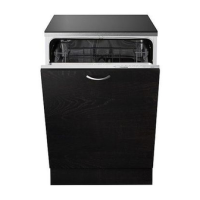The pressure and temperature of the
water, the variations of power supply
and the quantity of dishes can change these
values.
Use of the appliance
Refer to the following instructions for each
step of procedure:
1. Make a check if the water softener level
is correct for the water hardness in your
area. If necessary set the water soften-
er.
2. Fill the salt container with dishwasher
salt.
3. Fill the rinse aid dispenser with rinse
aid.
4. Load cutlery and dishes into the dish-
washer.
5. Set the correct washing programme for
the type of load and soil.
6. Fill the detergent dispenser with the
correct quantity of detergent.
7. Start the washing programme.
If you use detergent tablets, refer to
the chapter 'Use of detergent'.
Setting the water softener
The water softener removes minerals and
salts from the water supply. Minerals and
salts can have bad effect on the operation
of the appliance.
Water hardness is measured in equivalent
scales:
• German degrees (dH°).
• French degrees (°TH).
• mmol/l (millimol per litre - international
unit for the hardness of water).
•Clarke.
Adjust the water softener to the water hard-
ness in your area. If necessary, contact your
local water authority.
Water hardness Water hardness setting
°dH °TH mmol/l Clarke manually electronically
51 - 70 91 - 125 9,1 - 12,5 64 - 88 2 10
43 - 50 76 - 90 7,6 - 9,0 53 - 63 2 9
37 - 42 65 - 75 6,5 - 7,5 46 - 52 2 8
29 - 36 51 - 64 5,1 - 6,4 36 - 45 2 7
23 - 28 40 - 50 4,0 - 5,0 28 - 35 2 6
19 - 22 33 - 39 3,3 - 3,9 23 - 27 2 5
15 - 18 26 - 32 2,6 - 3,2 18 - 22 1 4
11 - 14 19 - 25 1,9 - 2,5 13 - 17 1 3
4 - 10 7 - 18 0,7 - 1,8 5 - 12 1 2
< 4 < 7 < 0,7 < 5
1
1)
1
1)
1) No use of salt required.
ENGLISH 9

